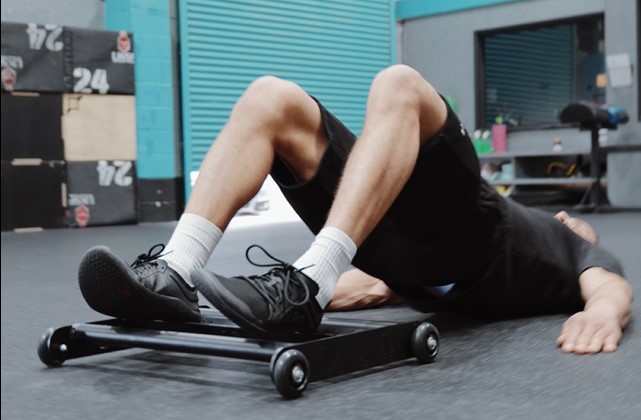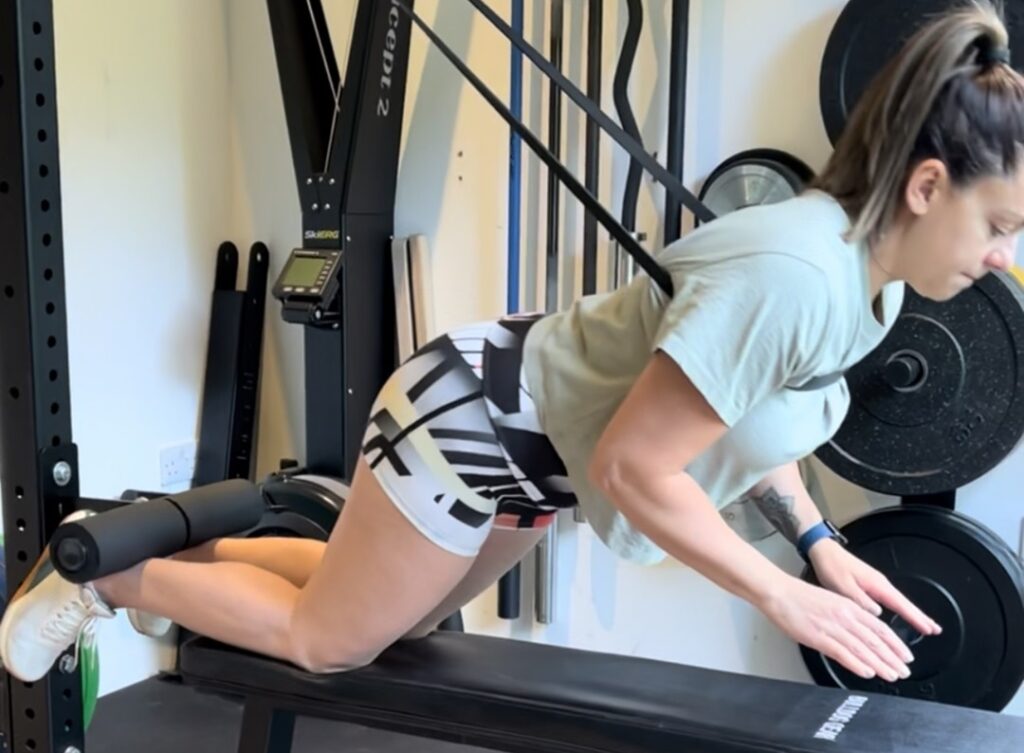What is the difference between GHR Hamstring Curl and Nordic curls?

Share This Post
Getting the Hang of GHR Hamstring Curl
The Glute Ham Raise (GHR) hamstring curl is a powerhouse move that focuses on your hamstrings and other key muscles in the back of your body. It’s a go-to for athletes and gym buffs who want to improve these muscle groups.
Muscles in Action
When you do a GHR hamstring curl, you’re mainly working your hamstrings, which include the biceps femoris, semimembranosus, and semitendinosus. But that’s not all—your glutes, calf muscles (gastrocnemius), and lower back also get in on the action. This exercise is a compound movement, meaning it works multiple joints and gives your lower body a solid workout.
Research using electromyography (EMG) to measure muscle activity found that the GHR, along with the Romanian deadlift (RDL), had the highest EMG ratings. This means these exercises really engage your muscles. Specifically, the GHR activates your biceps femoris and shows top EMG readings for the semimembranosus and semitendinosus during the upward phase of the move.
Why GHR ARE GROWING IN POPULARITY
The GHR hamstring curl delivers impressive benefits, making it a killer addition to any workout routine. It builds muscle strength and endurance in your hamstrings, boosting overall lower body power. Plus, it can enhance your athletic performance, especially in activities that require explosive moves.
One of the best parts of the GHR is how it helps your hamstrings grow and stay healthy, which can improve your game in various sports and reduce injury risks. Since it works the hamstrings at both the hip and knee joints, it can also improve hip extension, which is key for sprinting, jumping, and lifting.
Sure, the GHR is tough and needs a mix of mobility and hamstring strength, but it’s worth it. Stick with it, and you’ll see gains in your posterior chain and athletic performance.
Curious about how GHR stacks up against Nordic curls? Check out are nordic curls the same hamstring curls? for more info. And if you’re wondering how often to do GHRs, how many times a week should you do the nordic curl? has got you covered.
Exploring Nordic Hamstring Curl
The Nordic hamstring curl is a bodyweight exercise that’s been getting a lot of buzz for its hamstring-targeting prowess. Let’s break down the knee placement and why this move is a game-changer for your leg day.
Knee Placement
What sets the Nordic curl apart is where you put your knees. Unlike the glute-ham raise (GHR), where your knees rest on a machine pad, in a Nordic curl, your knees are right on the ground. This small tweak changes everything. When your knees press into the floor, your hamstrings have to work extra hard to control your descent and help you get back up if you’re doing the full movement.
Getting your knee placement right is key. It ensures your hamstrings are doing their job and helps prevent injuries. The beauty of the Nordic curl is that you don’t need much gear, and it’s easy to adjust for different fitness levels. So, whether you’re a newbie or a seasoned gym-goer, you can fit this into your routine. For more on knee placement and how to nail the Nordic curl, check out our article on are nordic curls the same as hamstring curls?
Effectiveness of Nordic Curl
The Nordic hamstring curl is a powerhouse for building hamstring strength. It makes your hamstrings support your entire upper body weight, leading to serious muscle activation and strength gains. Nordic curls are not only effective but can be adjusted for any fitness level, from beginners to pros.
This exercise is also known as a supramaximal load exercise. That means you’ll hit a point where you can’t lift yourself back up without help. This is great for muscle growth and endurance. If you want to focus on strengthening your hamstrings as they lengthen, stick to the eccentric (lowering) part of the lift.
Goal | Exercise Portion | Recommended Rep Scheme |
Strengthening | Eccentric Only | 5 sets of 3 reps |
Hypertrophy | Eccentric and Concentric | 3 sets of 5 reps |
These rep schemes are typical for supramaximal exercises and are explained further in our article on how many times a week should you do the nordic curl?
In a nutshell, the Nordic hamstring curl is a no-nonsense way to build hamstring strength. You don’t need fancy equipment, and you can do it almost anywhere. It’s a solid addition to any lower body workout plan.

Key Differences between GHR and Nordic Curl
When comparing the Glute-Ham Raise (GHR) and the Nordic Hamstring Curl, two main factors stand out: knee position and difficulty level. Knowing these differences is essential, especially if you’re thinking about getting a Nordic curls attachment.
Knee Positioning
The GHR and Nordic Curl differ a lot in knee placement during the exercise.
- GHR: Your knees rest on a pad, which stabilises your lower body and allows for controlled movement.
- Nordic Curl: Your knees are on the ground, changing the exercise dynamics by altering lever mechanics and making it tougher on your hamstrings.
The knee position affects the movement’s fulcrum. With GHR, the knees on the pad create an easier angle, while the Nordic Curl’s knee-on-ground setup demands more hamstring engagement to control your body’s descent and ascent.
Exercise | Knee Position | Fulcrum Effect |
GHR | On pad | Easier fulcrum |
Nordic Curl | On ground | More challenging fulcrum |
Difficulty Level
The difficulty level between these exercises is another big difference.
- GHR: This is more beginner-friendly and can be adjusted for different fitness levels. The Glute Ham Developer (GHD) machine supports your knees and anchors your body.
- Nordic Curl: Known for its difficulty, this exercise focuses on eccentric hamstring contraction. It requires a secure way to anchor your feet and is more demanding since you lower your torso towards the ground without knee support.
Nordic Curls are famous for targeting the hamstrings effectively and are often seen as a more advanced exercise due to the strength and control needed.
Exercise | Difficulty Level | Equipment Needed |
GHR | Beginner-friendly | GHD Machine |
Nordic Curl | Advanced difficulty | Partner or secure anchor |
For more tips on how often to do Nordic Curls, check out our guide on how many times a week should you do the nordic curl? If you want to dive deeper into the similarities and differences, our article are nordic curls the same hamstring curls? offers a detailed comparison.
Training Tips for Hamstring Exercises
Adding hamstring exercises like the GHR hamstring curl and the Nordic curl to your workout can be a game-changer. But, it’s crucial to tailor these exercises to your experience level and find the right rep scheme to get the most out of your efforts while avoiding injuries.
Beginners vs. Advanced
If you’re just starting out with hamstring training, the GHR hamstring curl is your best bet. You’ll need a Glute Ham Developer (GHD) machine, which supports your knees and keeps your body in the right position. This setup gives beginners the stability they need to learn the movement and really hit those hamstrings.
Now, if you’re more advanced, the Nordic curl might be up your alley. This one’s tougher because you need either a buddy or a way to anchor your feet while you lower your torso to the ground. Because it’s harder, the Nordic curl is usually better for folks who have been working out for a while. Want to dive deeper into the differences? Check out our article on are nordic curls the same hamstring curls?
Best Rep Schemes
The Nordic hamstring curl is a beast of an exercise, designed to push you to your limits. You’ll probably hit failure and need some help to finish the lift. A good rep scheme for this intense move is 5 sets of 3 reps or 3 sets of 5 reps. This gives you enough challenge without messing up your form.
Exercise | Sets | Reps |
Supramaximal Nordic Curl | 5 | 3 |
Supramaximal Nordic Curl (Alternate Scheme) | 3 | 5 |
If you find the Nordic curl easy, try doing it on one leg to keep it tough. If you stick with the two-leg version, go for higher reps like 3-4 sets of 6-12 reps. This way, you keep building strength without overdoing it.
Exercise | Sets | Reps |
Submaximal Bilateral Nordic Curl | 3-4 | 6-12 |
Wondering how often to do these exercises? Our article on how many times a week should you do the nordic curl? has got you covered. Remember, no matter what rep scheme or frequency you choose, consistency and good form are your best friends for strong, healthy hamstrings.

More To Explore
The Ultimate Guide to Skipping: Unlocking Strength, Balance, and Stress Relief with a flow rope
Flow rope training is a dynamic workout method that involves using a thick braided rope to create rhythmic, fluid movements. Unlike traditional jump rope exercises, a flow rope workout doesn’t necessarily require jumping. Instead, you move with the rope rather than against it, making it an excellent workout for balance, coordination, and relaxation. Popular among
The Benefits of Training with a Weighted Vest: Boost Your Strength and Endurance
Integrating a weighted vest into workout routines is an increasingly popular fitness strategy aimed at enhancing the effectiveness of various exercises. This comprehensive guide examines how weighted vests can significantly boost physical fitness by increasing the intensity of workouts, details the potential risks, and offers insights into maximising benefits while minimising potential drawbacks. What is